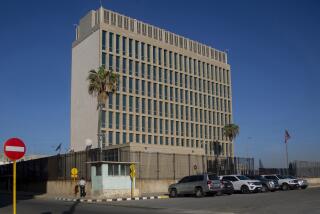Cuba and U.S. reopen embassies after 54 years
One of the last remnants of the Cold War faded into history Monday as the United States and Cuba quietly opened embassies on each other’s territory at the stroke of midnight, restoring full diplomatic relations and ending half a century of official estrangement between the neighboring nations.
With little fanfare, the State Department upgraded its diplomatic mission on the historic Malecon waterfront in Havana into a full-fledged embassy, and Cuba did the same at a stately mansion it owns in Washington’s Adams Morgan neighborhood, a focal point for Latinos in the capital.
Secretary of State John F. Kerry plans to visit Havana on Aug. 14 to raise the U.S. flag over the embassy for the first time since the Eisenhower administration severed ties with Cuba in 1961.
Shortly after 4:30 a.m., still long before sunrise, the single-star Cuban flag was added to the array of more than 190 other flags in the State Department’s cavernous marble lobby. A State Department video shows a worker on a squeaky hydraulic lift placing the red, white and blue banner into a flag holder next to the Croatian colors.
Bruno Rodriguez, Cuba’s foreign minister, later hoisted a Cuban flag up a gleaming white pole in front of Havana’s three-story embassy on 16th Street and before about 500 invited guests, including several members of Congress, on a sweltering morning. Moments later, the Cuban national anthem blared through loudspeakers.
Assistant Secretary of State Roberta Jacobson, who led the talks to restore ties, was the highest-ranking U.S. diplomat to attend. The White House sent Ben Rhodes, a deputy national security advisor who took part in secret diplomacy with the Vatican that helped create the opening.
Protesters outside waved signs and chanted slogans both for and against Cuba’s communist government. But the crowds were small and the protests were peaceful, a sign of how passions have cooled after five decades of high drama that included the failed Bay of Pigs invasion in the Kennedy administration, the subsequent Cuban missile crisis and the Mariel boatlift of 1980, when more than 100,000 Cuban refugees took to the seas to reach Florida.
The events Monday fulfilled a long-sought goal for President Obama, who pushed to end what he called a failed U.S. policy by easing tension with Havana.
“This is yet another demonstration that we don’t have to be imprisoned by the past,” the White House said in a statement.
“We look forward to collaborating with the Cuban government on issues of common interest, including counterterrorism and disaster response,” the statement reads. “And we are confident that the best way to advance universal values like freedom of speech and assembly is through more engagement with the Cuban people.”
But many in Congress, upset about Cuba’s human rights record and other concerns, appear determined to maintain the decades-old trade embargo. So the next big steps toward normalization are unclear.
Speaking at the new embassy, Rodriguez mixed Cuban revolutionary doctrine with thanks to Obama and Cuban President Raul Castro for ending the diplomatic deep freeze. He said restoring ties will “pave the way to the complex and certainly long process toward the normalization of bilateral relations.”
But Rodriguez said only the lifting of the trade embargo, return of the U.S. Navy base at Guantanamo Bay and “respect for Cuba’s sovereignty will lend some meaning to the historic event that we are witnessing today.”
U.S. officials who attended obviously supported the opening. Harsh critics in Congress stayed away.
“It’s never just symbolic when two countries establish diplomatic relations,” said Rep. Jose E. Serrano (D-N.Y.) “It was a very emotional moment with lots of tears when Bruno said ‘Welcome.’”
In a statement, Sen. Robert Menendez (D-N.J.), a Cuban American who opposes the opening, said diplomatic relations with Washington “are a privilege and must be earned, yet the Cuban government refuses to make any substantial changes to uphold democratic principles and human rights.”
Appearing later with Rodriguez at the State Department, Kerry hailed the thaw “as a time to start repairing what has been broken, and opening what for too long has been closed.”
Kerry said the effort will be “long and complex. Along the way, there are sure to be bumps in the road and moments of frustration. Patience will be required.”
In Havana, the scene was more low-key. No flag was raised at the newly converted embassy, but some American tourists held ad-hoc celebrations, waving tiny flags and taking selfies. A new page for the U.S. Embassy in Havana appeared on the State Department website, with a fact sheet on how the mission will operate.
The six-story building has a storied past as a crucial listening post for the Americans — a hotbed of espionage as far as the Cubans were concerned. Until recently, a huge banner hung by Cubans across the plaza proclaimed, “Fatherland or death!”
One issue that still rankles the Cubans is the U.S. request for diplomats to have freedom to visit dissidents, whom the Castro government regards as U.S.-paid mercenaries with next to no relevance on the island.
“We are hoping with the new diplomatic level, the Americans will be able to have more contact with people who are more representative of Cuban society,” said a Cuban official who was not authorized to speak publicly.
Times staff writer Tracy Wilkinson in Mexico City contributed to this report.
For foreign policy news, follow me at @richtpau.
More to Read
Start your day right
Sign up for Essential California for news, features and recommendations from the L.A. Times and beyond in your inbox six days a week.
You may occasionally receive promotional content from the Los Angeles Times.







